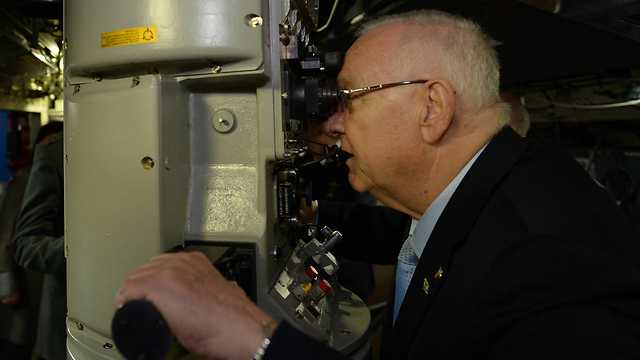President Rivlin visits German shipyard in Kiel, where Israeli commandos are presently training to operate new INS Rahav, which is expected to arrive in Haifa during the upcoming year.
By Roi Yanovsky
President Reuven Rivlin visited the Kiel shipyards in Germany on Wednesday, receiving a private tour aboard the INS Rahav – the fifth submarine expected to arrive in Israel.
“You are our fortified wall on our maritime borders, and nowhere is too far for you when it comes to Israel’s safety,” the president told the submarine commandos.
The tour of the submarine was held on the last day of Rivlin’s visit to Germany to mark 50 years of diplomatic relations between the two nations.
The INS Rahav was launched some two years ago and will arrive in Israel this year. According to an agreement with Germany, Israel will procure a sixth submarine in the future.
The president was welcomed by the naval commandos who have been staying in Kiel for several years now to prepare the submarine for its arrival in Israel.
Colonel A, head of the Dolphin submarine AIP project (a propulsion system for submarines not reliant on external air) attended the event along with the commander of the submarine Lieutenant Colonel S.
Colonel A presented President Rivlin with a picture of former prime minister David Ben Gurion looking through a periscope of a INS Rahav submarine, which Israel’s first prime minister named.

Rivlin inside submarine. – Photo: Amos Ben Gershom/GPO
The submarine commandos introduced themselves to Rivlin and told him about their families who had joined them during their mission in Kiel, as well as their years of training in the IDF.
“It is well know that I am a Jerusalemite, and not connected to the sea in any specific way, but as an officer in the IDF, I always viewed with admiration those who served in the Navy, and knew the difficulties and dangers which are inherent in defending Israel from the sea,” said Rivlin.
“Meeting with you is very moving for me. For many years, we didn’t understand to what extent the navy was important to the security and economic prosperity of Israel… I have come here today, to thank you for your courage in the name of Israel’s people.
“Even when you are far from us, your influence as a strategic asset of the State of Israel is closely felt. It is not easy to be so far from home, and I can only tell you how much I and the people of Israel thank each and every one of you for your devotion and dedication. I look forward to the moment we will welcome you safely home,” said Rivlin.
The president was the first to sign the submarine’s guest log and put up a souvenir plaque in the submarine’s briefing room that read: “The greatest strength of a submarine is in the beating heart, in the crew that operates it, working together as one every moment of every day, alert, vigilant, and determined. Even from afar, under cover, or in the depths, our hearts are with you. May it be God’s will that you will go and return in peace, and that you will be successful in your mission of the continued defense of the State of Israel and her residents.”
At the end of Rivlin’s tour, the submarine’s commandos greeted him with an honor guard and the visit was concluded with the singing of Hatikvah on the INS Rahav. (pictured above)
Before he met with the Israeli commandos, Rivlin was greeted by Kiel shipyard officials who briefed him on a range of joint projects between the Kiel shipyard and the Israeli Navy.
The shipyard officials also briefed him on the project’s progress which includes four ships to be sent to Israel for the protection of gas rigs in Israel’s “economic waters.”
On Monday, the director-general of the Defense Ministry, Dan Harel, signed the deal worth 1.8 billion shekel (430 million Euro). Germany will subsidize about a third of the deal.
The first ship will arrive in Israel in five years, after its construction is completed. The three additional ships will arrive later in one year intervals.
View original Ynet publication at: http://www.ynetnews.com/articles/0,7340,L-4657303,00.html







 Israeli New Shekel Exchange Rate
Israeli New Shekel Exchange Rate